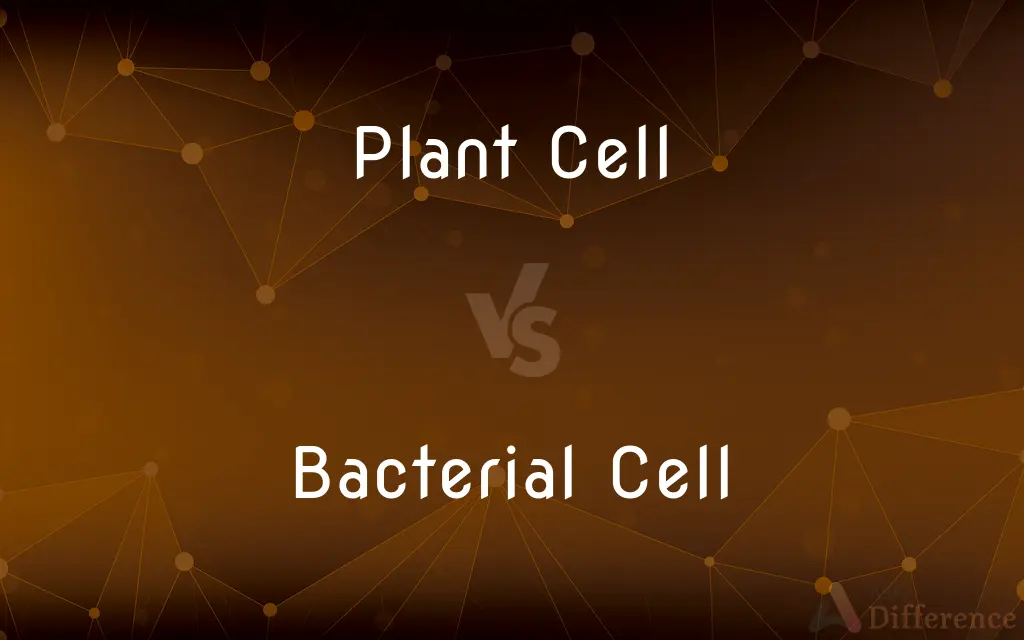Plant Cell vs. Bacterial Cell — What's the Difference?
By Tayyaba Rehman — Published on November 22, 2023
Plant Cells have a cell wall, chloroplasts, and a large central vacuole, while Bacterial Cells are simpler, without these organelles, and have a singular circular DNA.

Difference Between Plant Cell and Bacterial Cell
Table of Contents
ADVERTISEMENT
Key Differences
Plant Cells are eukaryotic, which means they have a true nucleus containing genetic material enclosed within a nuclear envelope. Bacterial Cells, on the other hand, are prokaryotic, lacking a true nucleus, and instead have their genetic material in a single circular molecule.
One defining feature of Plant Cells is the presence of chloroplasts, which are responsible for photosynthesis. Bacterial Cells do not have chloroplasts, though some bacteria can perform photosynthesis using different structures.
The cell wall is a common feature in both Plant Cells and Bacterial Cells, but their compositions differ. Plant Cells have cell walls made of cellulose, while Bacterial Cells possess cell walls primarily made of peptidoglycan.
Plant Cells also have a unique large central vacuole responsible for various functions, including waste management and maintaining cell turgor. Bacterial Cells don't have such a vacuole but might have smaller vesicles.
Size-wise, Plant Cells are generally larger, often ranging from 10 to 100 micrometers in diameter. Bacterial Cells are typically smaller, with diameters usually between 0.5 to 5 micrometers.
ADVERTISEMENT
Comparison Chart
Cell Type
Eukaryotic
Prokaryotic
Genetic Material
Enclosed in a nucleus
Singular circular molecule
Presence of Organelles
Has organelles like chloroplasts
Lacks these organelles
Cell Wall Composition
Made of cellulose
Made of peptidoglycan
Size
Generally 10-100 micrometers
Typically 0.5-5 micrometers
Compare with Definitions
Plant Cell
The basic structural and functional unit of plants.
The Plant Cell wall provides support and rigidity to the plant.
Bacterial Cell
The basic unit of bacteria, typically very small.
A Bacterial Cell divides rapidly under favorable conditions.
Plant Cell
A eukaryotic cell of plants with a true nucleus.
The leaf's green color comes from chloroplasts in the Plant Cell.
Bacterial Cell
A prokaryotic cell without a true nucleus.
The genetic material in a Bacterial Cell is found in a singular circular molecule.
Plant Cell
Contains organelles like chloroplasts and mitochondria.
The Plant Cell utilizes chloroplasts for photosynthesis.
Bacterial Cell
Lacks organelles like chloroplasts and mitochondria.
The Bacterial Cell carries out cellular functions in the cytoplasm.
Plant Cell
Houses a large central vacuole for various functions.
The large central vacuole in the Plant Cell stores water and nutrients.
Bacterial Cell
Houses ribosomes for protein synthesis.
The Bacterial Cell uses ribosomes to manufacture essential proteins.
Plant Cell
Enclosed by a cellulose-rich cell wall.
The rigidity of the Plant Cell wall helps it maintain shape.
Bacterial Cell
Contains a cell wall made of peptidoglycan.
The Bacterial Cell wall offers protection and maintains its shape.
Common Curiosities
What kind of cells are Plant Cells?
Plant Cells are eukaryotic cells.
Do Bacterial Cells perform photosynthesis?
While Bacterial Cells don't have chloroplasts, some bacteria can perform photosynthesis using different structures.
Why do Plant Cells have a green appearance?
The green color of Plant Cells is due to chlorophyll in chloroplasts.
Are Bacterial Cells larger than Plant Cells?
No, Bacterial Cells are typically smaller than Plant Cells.
Can Bacterial Cells cause diseases in plants?
Yes, certain Bacterial Cells can infect and cause diseases in plants.
What's the function of the cell wall in Plant Cells and Bacterial Cells?
The cell wall provides support, protection, and maintains the shape of both Plant Cells and Bacterial Cells.
Do Bacterial Cells have organelles like Plant Cells?
No, Bacterial Cells lack membrane-bound organelles found in Plant Cells.
What kind of cells are Bacterial Cells?
Bacterial Cells are prokaryotic cells.
Do Bacterial Cells have a nucleus?
No, Bacterial Cells don't have a true nucleus like Plant Cells.
Why do Plant Cells have a large central vacuole?
The large central vacuole in Plant Cells stores water, nutrients, and waste and helps in maintaining cell turgor.
What's the main component of the Plant Cell wall?
The main component of the Plant Cell wall is cellulose.
How do Plant Cells and Bacterial Cells reproduce?
Plant Cells reproduce via mitosis and meiosis, while Bacterial Cells reproduce primarily through binary fission.
Can Plant Cells move like Bacterial Cells?
No, while some Bacterial Cells can move using structures like flagella, Plant Cells are stationary.
Share Your Discovery

Previous Comparison
Sulfite vs. Sulfur Trioxide
Next Comparison
Apart vs. A PartAuthor Spotlight
Written by
Tayyaba RehmanTayyaba Rehman is a distinguished writer, currently serving as a primary contributor to askdifference.com. As a researcher in semantics and etymology, Tayyaba's passion for the complexity of languages and their distinctions has found a perfect home on the platform. Tayyaba delves into the intricacies of language, distinguishing between commonly confused words and phrases, thereby providing clarity for readers worldwide.
















































